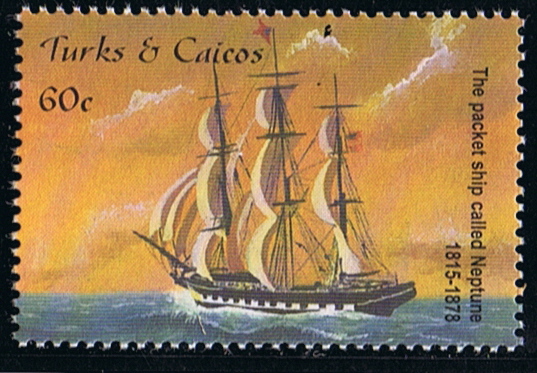
She was built by William H.Webb at New York in 1855 for Charles H.Marshall- & Co. (The Black Ball Line. To distinguishing the ships of this line with ships of other companies, she had a large black ball painted or sewn on her fore topsail.
Launched under the name "NEPTUNE".
Tonnage 1.603 register tons, dim. 191 x 40 x 28ft.
Built of white oak and live oak, three decks, ship rigged.
Her maiden voyage was under command of Capt. Enoch W.Peabody. She was a well know ship on the North Atlantic route carrying passengers and cargo between New York and Liverpool.
She was later forced out of this trade by the steamships. 1868 Put in the service between New York, San Francisco and Liverpool.
1871 Captain James H. Spencer took over command.
Made altogether four slow round voyages, her last arrival in Liverpool was in January 1876, with a cargo of grain. After discharging and loading she sailed for New York.
13 April 1876 a dense fog set in, and there was not any change to get any observation, on the 15th during the night and under full sail with a speed of eight knots, she went ashore on Sable Island, an island east of Nova Scotia. After grounding the ship rolled heavy in the seas, both rails were alternately under water.
Boats were launched but already by launching stove in, and much needed provision was lost. Later three others boats were successfully launched but at that time the provision was out of reach.
In Captain Spencer's boat were his wife and four children, the oldest 7 and the youngest nine months.
During the night the boats stayed alongside the "NEPTUNE", the next morning the Chief Mate boat made a landing. The second mate boat was out of sight, and the captain boat was driven out to sea. The captain boat stayed out at sea, three nights and days before they could land, and they on board suffered greatly from exposure and frostbites, the only provision on board was a raw ham and a little water.
After landing the exhausted survivors walked along the beach for about seven miles before the lighthouse was observed.
One man died in the sand and the other were so exhausted they could go not more further. Two of the strongest went ahead for assistance and alert the lighthouse keeper. An ox team was send out and took the rest of the party to the lighthouse.
On arrival at the lighthouse it was discovered that the occupants of the other two boats had arrived, but the provision in the lighthouse was very low, and the last time there had been any communication with the mainland of Canada was five months ago. After the 34 people of the "NEPTUNE" arrived at the lighthouse, anybody was put on the lowest possible allowance. The prospects for relief were very poor, but lucky after several days an American fishing schooner arrived, and arrangements were made by Capt. Spencer to have his crew taken to Halifax. The schooner had a crew of 15 and when the 34 people of the "NEPTUNE" embarked, accommodation must be tight. But the voyage was made without mishap and the survivors landed safely at Halifax.
By 9 May 1876 the "NEPTUNE" was completely wrecked and had disappear under water with all her cargo.
She was valued at $ 65.000 but she was not insured.
Mr.Edward Hogan gives in Log Book of June 2001 that the stamp was designed after an oil painting of 1866 by J~ E.C. Peterson; it depict the "NEPTUNE" passing through the Grand Banks fishing fleet in 1866. The inscription on the stamp 1815-1878 is the period for which the Black Ball Line existed.
Turks & Caicos Islands 2001 60c sg?, scott ?
Source The Western Ocean Packets, Basil Lubbock. American Merchant Ships 1850-1900 by Frederick C.Matthews. Log Book
